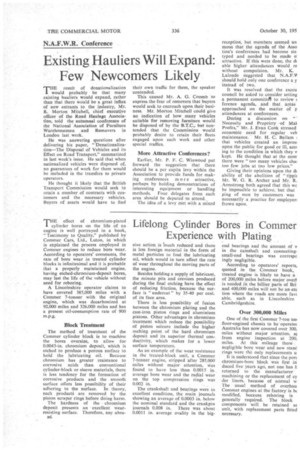Lifelong Cylinder Bores in Commer Experience with Plating
Page 40

If you've noticed an error in this article please click here to report it so we can fix it.
THE effect of chromium-plated cylinder bores on the life of an engine is well portrayed in a book, "Testimony to Quality," published by Commer Cars, Ltd., Luton, in which is explained the process employed in Commer engines to reduce bore wear. According to operators' comments, the rate of bore wear in treated cylinder blocks is infinitesimal and it is probable that a properly maintained engine, having etched-chromium-deposit bores, may last the life of the vehicle without need for reboring.
A Lincolnshire operator claims to have covered 385,000 miles with a Commer 7-tonner with the original engine, which was decarbonized at 92,000 miles and 326,000 miles and has a present oil-consumption rate of 900 m.p.g.
Block Treatment
The method of treatment of the Commer cylinder block is to machine the bores oversize, to allow for 0.00.43-in, chromium deposit, which is etched to produce a porous surface to hold the lubricating oil. Because chromium has greater resistance to corrosive acids than conventional cylinder-block or sleeve materials, there is less tendency for the formation of corrosive products and the smooth surface offers less possibility of their adhering to the surface. In theory, such product i are removed by the piston scraper rings before doing harm.
The hardness of the chromium deposit presents an excellent wearresisting surface. Therefore, any abra n6 sive action is 'Much reduced and there is less foreign material in the form of metal particles to foul the lubricating oil, which would in turn affect the rate of wear throughout the moving parts of the engine.
Besides holding a supply of lubricant, the minute pits and crevices produced during the final etching have the effect of reducing friction, because the surface is " undercut " by 35-40 per cent. of its face area.
There is less possibility of fusion between the chromium plating and the cast-iron piston rings and aluminium pistons. Other advantages in chromium treatment which reduce the possibility of piston seizure include the higher melting point of the hard chromium deposit and its superior thermal conductivity, which makes for a lower surface temperature.
As an example of the wear resistance in the treated-block unit, a Commer 7-tonner engine, stripped after 285,000 miles without major attention, Was found to have less 'than 0.0015 in. average bore wear and the radial wear on the top compression rings was 0.002 in.
The crankshaft and bearings were in excellent condition, the main journals showing an average of 0.0003 in. below the nominal standard and the crankpin journals 0.008 in. There was about 0.0011 in. average ovality in the big end bearings and the amount of v in the camshaft and connectingsmall-end bearings was correspo ingly negligible.
According to operators' reports, quoted in the Commer book, treated engine is likely to have a of 200,000 miles before major overt is needed in the hillier parts of Bri and 40,000 miles will not be an-ext tion where the roads are more fay( able, such as in Lincolnshire Cambridgeshire.
Over 300,000 Miles One of the first Cormier 7-ton um floor-engined chassis to be' operate( Australia has now covered over 300, miles without major attention, al from engine inspection at 200,
miles. At this mileage there. negligible bore wear and new stand rings were the only replacements u It is understood that since the port chromium-bore block was first in duced five years ago, not one has b returned to the manufacturer machining or the replacement of cy der liners, because of normal w The usual method of overhau Commer engines at the factory is bt modified, because reboring is generally required. The block components will be retained as unit, with replacement parts fitted necessary.




















































































